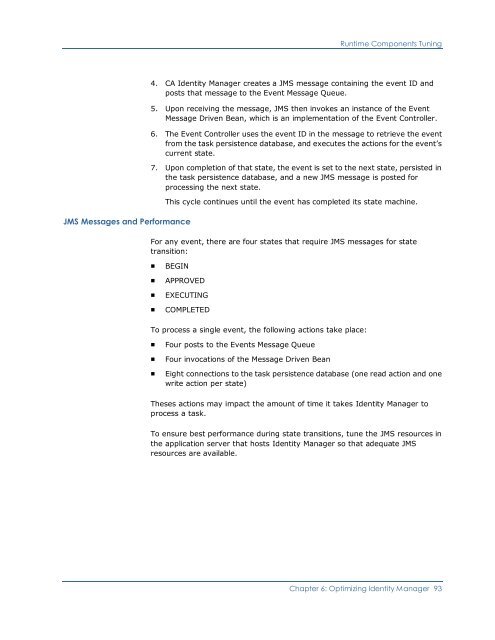CA Identity Manager Implementation Guide - CA Technologies
CA Identity Manager Implementation Guide - CA Technologies
CA Identity Manager Implementation Guide - CA Technologies
- No tags were found...
Create successful ePaper yourself
Turn your PDF publications into a flip-book with our unique Google optimized e-Paper software.
Runtime Components TuningJMS Messages and Performance4. <strong>CA</strong> <strong>Identity</strong> <strong>Manager</strong> creates a JMS message containing the event ID andposts that message to the Event Message Queue.5. Upon receiving the message, JMS then invokes an instance of the EventMessage Driven Bean, which is an implementation of the Event Controller.6. The Event Controller uses the event ID in the message to retrieve the eventfrom the task persistence database, and executes the actions for the event’scurrent state.7. Upon completion of that state, the event is set to the next state, persisted inthe task persistence database, and a new JMS message is posted forprocessing the next state.This cycle continues until the event has completed its state machine.For any event, there are four states that require JMS messages for statetransition:■■■■BEGINAPPROVEDEXECUTINGCOMPLETEDTo process a single event, the following actions take place:■■■Four posts to the Events Message QueueFour invocations of the Message Driven BeanEight connections to the task persistence database (one read action and onewrite action per state)Theses actions may impact the amount of time it takes <strong>Identity</strong> <strong>Manager</strong> toprocess a task.To ensure best performance during state transitions, tune the JMS resources inthe application server that hosts <strong>Identity</strong> <strong>Manager</strong> so that adequate JMSresources are available.Chapter 6: Optimizing <strong>Identity</strong> <strong>Manager</strong> 93
















